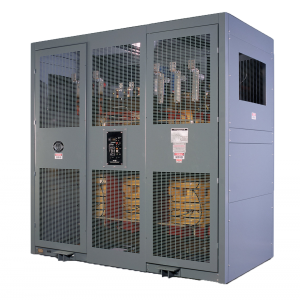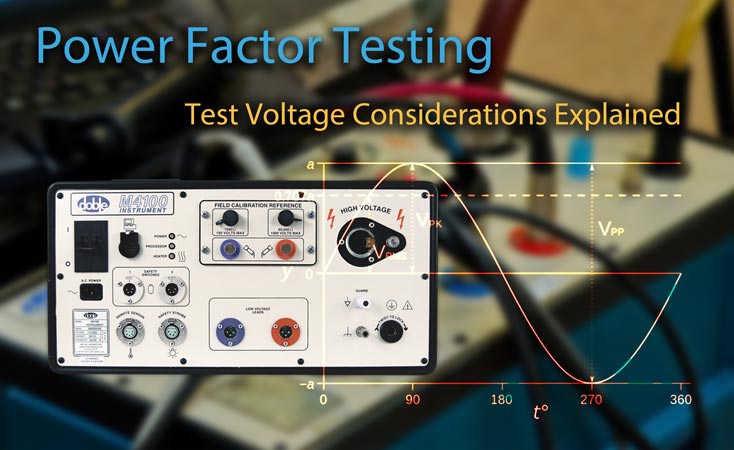The first step in any comprehensive testing approach is to create a plan that ensures the safety of both the equipment under test and personnel performing the test. Keeping the device under test safe means applying an appropriate test voltage for the rated insulation.
Power factor testing, by nature, should be non-destructive, implying that performing the test should cause no measurable harm to the apparatus insulation. This objective is achieved by keeping test levels below the line-to-ground voltage rating of the test specimen.
Insulation that is believed to be deteriorated should always be considered unable to sustain routine test voltage and therefore tested at 2kV or less at first. If the measured readings do not indicate a problem, the test voltage is gradually raised in steps up to the maximum value allowed.
The equipment manufacturer and industry standards should always be consulted whenever questions arise regarding the proper test voltage for a specific piece of equipment. While the final say ultimately falls on the apparatus owner, it is the job of the test engineer to help make an informed decision.
It’s important to remember that apparatus voltage ratings are based on the system line-to-line voltage, but Power Factor testing is applied at a line-to-ground value. Choosing a power factor test voltage can be accomplished by breaking down apparatus into three main categories based on their insulation rating and type.
1. Apparatus Rated Above 15kV
The four major voltage classes are 5, 15, 25, and 35kV. The term system voltage class refers to a set of insulation ratings and is not the actual system voltage. For example, a 15kV insulator is suitable for application on any 15kV class voltage, including 12.47kV, 13.2kV, and 13.8kV.
In most cases, liquid-filled and dry-type equipment with a voltage class rating above 17.3kV (typically 25kV) will have line-to-ground operating voltage ratings at 10kV and above. As a rule of thumb, 10kV should be an appropriate power factor test voltage standard for most equipment rated above 15kV class (25kV and up).

Apparatus voltage ratings are based on the system line-to-line voltage but Power Factor testing is applied at a line-to-ground value. Photo: Paul Chernlkhowsky
There are exceptions to this rule for grounded apparatus such as arrested stacks, line-to-ground PTs, and tap-insulation of bushings where test voltages should be kept under 10kV. Insulation that is believed to be deteriorated or damaged should also be tested at a lower value first.
2. Liquid-Filled Apparatus Rated 15kV and Below
Special considerations should be made when power factor testing electrical apparatus rated 15kV and below in accordance with the insulation design level. The application of test values 10-25% above the rated line-to-ground value may not be considered a destructive test if the insulation is designed to withstand a much higher voltage.
For liquid-filled apparatus rated 15kV class, the overall tests are usually performed at 10kV, although this voltage may be higher than the operating line-to-ground rating. Considering the insulation design level, this voltage would not be considered destructive.
Voltage Class vs. Operating Voltage
A 15-kV insulator is suitable for application on any 15-kV class voltage, including 12.47 kV, 13.2 kV, and 13.8 kV
- 15kV line-to-ground is 8.66kV. 10kV is 15% above the insulation line-to-ground design level
- 13.8kV line-to-ground 8kV. 10kV is 25% above operating line-to ground rating
- 13.2kV line-to-ground 7.62kV. 10kV is 31% above operating line-to ground rating
- 12.47kV line-to-ground 7.16kV. 10kV is 39% above operating line-to ground rating
For liquid-filled equipment rated below 15kV class, the standard practice is to choose a test voltage at convenient whole number values below the nominal system line-to-line voltage. There may be restrictions in cases of line-to-ground PTs with a low voltage rating at the neutral terminal of the primary winding.
- 4.16kV equipment: Test at 1 to 4kV
- 2.3kV equipment: Test at 1 to 2kV
3. Dry-Type Apparatus Rated 15kV and Below
Routine power factor tests on dry-type apparatus rated 15kV and below are generally performed at several voltages because this equipment is susceptible to corona damage (ionization losses). The initial test is performed at a low test voltage (1 or 2kV) and continued in steps, up to the operating line-to-ground voltage.

Routine power factor tests on dry-type apparatus rated 15kV and below are generally performed at several voltages. Photo: Square D.
Example Test Voltage
- 13.8kV Dry-Type Transformer: 2kV, 3kV, 5kV, 8kV
- 12.46kV Dry-Type Transformer: 2kV, 3kV, 5kV, 7kV
- 4.16kV Dry-Type Transformer: 1kV, 2.4kV
- 480V Dry-Type Transformer: 0.12kV, 0.277kV
Depending on the test results obtained up to the line-to-ground level, additional tests can be performed at 10-25% over this rating to help accentuate any corona conditions that were undetected at the previous test values. Power factor testing at 10-25% over the line-to-ground rating is not considered destructive for insulation in good condition, as it is designed to withstand considerably higher voltage levels.
Examples of dry-type apparatus that are candidates for tests that exceed line-to-ground ratings include air-magnetic circuit breakers, cables, rotating machinery, and instrument transformers.
Summary
Power factor testing is non-destructive by design, and test voltages are kept at or below line-to-ground ratings. Equipment that is believed to be deteriorated should always be considered unable to sustain routine test voltage and therefore tested at 2kV or less at first.
10kV should be an appropriate power factor test voltage standard for most equipment rated 25kV and above. Special considerations should be made when power factor testing electrical apparatus rated 15kV and below in accordance with the insulation design level.
For liquid-filled apparatus rated 15kV class, the overall tests are usually performed at 10kV, although this voltage may be higher than the operating line-to-ground rating. For liquid-filled equipment rated below 15kV class, the standard practice is to choose a test voltage at convenient whole-number values below the nominal system line-to-line voltage.
Routine power factor tests on dry-type apparatus rated 15kV and below are generally performed at several voltages because this equipment is susceptible to ionization losses. Power factor testing at 10-25% over the line-to-ground rating is not considered destructive for insulation in good condition as they are designed to withstand considerably higher voltage levels.
References
- Doble Test Procedures, Rev. C
- Primary Distribution Levels
- Power Factor Testing of Power and Distribution Transformers
- Power Factor Testing Dry Type Transformers

